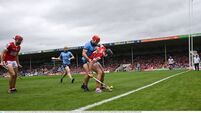The big splash was delivered skilfully and strategically. The day before the AFL announced their 2022 fixture schedule, the AFLW general manager and a host of players gathered at Melbourne’s Marvel Stadium. Determined to make a statement.
Simultaneously, a well-produced video appeared on social media, promoting a bright future. The Women’s Coach Acceleration Programme was launched. Then came the big pledge. A Women’s Football Vision for 2021-2030. AFLW players will become the best-paid sportswomen in an Australian domestic competition and at least half of the AFLW senior coaches will be women by 2030.
For sporting bodies around the world, shedding the Covid obstacles has been like trying to escape quicksand. Heading into their sixth season, the league knew a firm launchpad was crucial.
“Last year was crazy obviously, but overall, I really enjoyed it,” explains Tipperary native and West Coast Eagles star Aisling McCarthy.
She is busy preparing for her fourth season Down Under and was recently named in the side’s leadership group. “The whole league, especially the standard, was up another notch again. The extra few hours we have now are starting to show. Players are fitter and faster.
“There are better pathways now too. When the competition started, teenagers went into academies and underage competitions. Their programmes are really good, so we are getting ready-made talent now.”
This is a crucial campaign, in more ways than one. The current collective-bargaining agreement ends in 2022. As attendances, standards, and the number of teams increases, so too must the incentives.
“For me, it was important to gradually grow the game. Improve the standard of the competition and everything with that. Increasing attendance and making a brand of it, I think they have got to that point. You had to pay to go to games last season and it didn’t slow down attendances.
“The broadcasting is better, and they have been really good at gradually growing the game. Four new teams joining next year means another 130 spots, it is a massive chunk of players to find somewhere. For the standards to stay high, I actually think they need to be slow with it. The problem is that at the same time, you have girls trying to balance full-time jobs in a league with increasing demands.”
Under the current CBA, player payments are based on four tiers. A select few occupy Tier 1, $37,155 (€23,757) for 2022. The scale descends from there to Tier 4, $20,239 (€12,941) — up from $13,400 (€8,568) in 2019. As a result, the total team payment stands at $717,122 (€458,569). Any increase from here must be balanced with the addition of four new clubs for 2023. It has been mooted that this expansion will result in another crop of Irish recruits, but CrossCoders agent Jason Hill isn’t so sure.
Hill will manage 10 Irish players in 2022. Crosscoders are also currently accepting expressions of interest for 2023 via their website. Yet the focus looks set to be on quality rather than quantity.
“It is interesting. You speak to clubs now; a lot are concerned whether they have the capacity to take care of out-of-state players and Irish players all at the same time. Look at the last expansion, only two clubs brought in Irish players. It took until now for Geelong to take on a player (Mayo’s Rachel Kearns), two years after they joined.
“The more established clubs want to know who is out there because players could leave to go elsewhere but increasingly clubs are saying: ‘I want to see them here beforehand’. It is a harder sell, I would say, than it was pre-Covid. The talent pool has grown too so there is not as pressing a need to look elsewhere.”
Some are likely to pursue alternative routes. The Irish Examiner understands former Fermanagh captain Joanne Doonan, who spent a season with Carlton in 2020, is edging towards joining a VFL outfit next January with the hope of earning an AFLW deal through that.
A strategic review is under way, but Hill hopes the players’ genuine expectations, not perceived ones, are what influence the next step.
“I think there is a huge misconception across the board that the female players want to be paid the same as men to go full-time. That is not the case. They would happily take a full-time wage to be a full-time athlete. I don’t think it is a huge jump. There seems to be a perception they want the same. If you actually ask the players, they would take a middling step.”
There are obvious ramifications for Irish players too. While it has been widely reported that several stars recently signed two-year deals, it should be noted most contracts have an opt-out clause ahead of the new CBA.
Furthermore, the Irish pathway is still evolving. It was not so long ago that certain prospects saw their relocation fees squandered on their flights out. While that wasn’t necessarily wrong, most established clubs absorb the travel costs themselves and utilise relocation fees for accommodation. Much of these missteps are due to a lack of understanding, not malpractice.
A minimum standard for Irish recruits is necessary. The AFL players association are conscious of that. As well as payments and league progression, another issue has arisen around pathways.
Closer to home, a fallout within AFL Ireland is yet to be fully resolved after former Banshees coach Mike Currane left the organisation this year.
Currane is the current operator of the AFLW Ireland and a skills coach who works with several current players, including Bríd Stack, Ailish Considine, Aisling McCarthy, Orla O’Dwyer, and Lauren Magee. It is understood the AFLW hierarchy are aware of the situation and arbitration is ongoing.
Hill has worked with Currane previously. When asked about his thoughts on the matter, he suggested the official channels are the best avenue available for any possible intercounty recruits.
“There is an official process in place with the AFL Players Association, not even with the AFL, to be a registered player representative because they believe unless you go through a certain level of training and background checks in the industry, something could happen.
“It helps, especially for the worst-case scenario. If something goes awry and a player wants to complain. For example, if something goes awry with Crosscoders, they have the AFL PA who we report to. If something is completely untoward, they can take away our licence to practice as an agent. If any player is looking at a way to get to the AFLW, they should probably look into the official channels. That is not just Crosscoders. There are hundreds of agents registered who can help out.”
Currane, who helped found AFL Ireland in 2000, remains solely focused on elite AFLW coaching, talent identification, and development.
“I’m currently working with a number of leading players on an ongoing basis on skills development and assisting with introductions and exploring AFLW opportunities with AFLW clubs,” he explained when contacted.
“I think it’s important to highlight that any player can make contact with an AFLW club themselves directly and there is no requirement for them to pay out fees to join any programmes, or commissions to agents. I look forward to seeing some more Irish players signed up across the next couple of seasons.”
The league continues to trundle towards the ultimate goal of a full-time league.
What is becoming obvious is that in Ireland and Australia, it will encounter its fair share of speedbumps along the way.

Unlimited access. Half the price.
Try unlimited access from only €1.50 a week
Already a subscriber? Sign in
CONNECT WITH US TODAY
Be the first to know the latest news and updates














